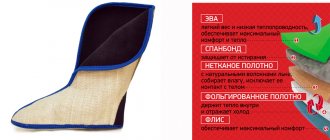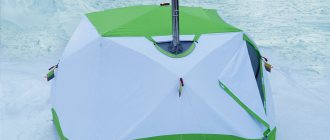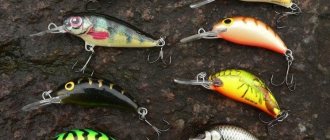Types of jigs
An experienced fisherman keeps different types of jigs in a box.
Summer and winter baits
Summer and winter baits differ in weight. In summer, the upper layers of the reservoir are filled with fry, which attack any bait, which means they do not allow it to reach the bottom, where large fish swim. To protect the bait, summer jigs are made heavier than winter models.
In summer, the water in the reservoir is more cloudy, so the color of the jig should be brighter.
The winter jig is smaller in size than the summer bait. This is necessary so that the bait looks more believable in clear water.
Moths and mothless
Bloodworm is the most catchy bait. This bait is very delicate, which means it is not difficult for the fish to knock it off the hook. Experienced fishermen start fishing with reelless reels and then switch to baits.
Mothless fish resemble insects that are part of the fish’s diet, so it bites without fear. For better attractiveness, the bait is decorated with shiny threads. In some cases, sprays with a special aroma are used. Moths with an animal bait increase the chance of a bite, since fish have a well-developed sense of smell.
Form
The behavior of the bait depends on the shape if there is a current or standing water. A jig with a teardrop shape when retrieved imitates an insect caught in the water. This bait is usually attacked by perch and ide.
The flattened jig resembles a butterfly. When wiring near the bottom, a cloudy cloud is created. It attracts curious fish.
Weight
Since reservoirs come in different depths and with different current intensities, baits are needed that will have different weights. They are made light, medium weight and heavy.
Cargo material
To make the bait sink faster to the set depth, it is made heavier. Tin, lead, and tungsten are used as weighting materials.
Color
To make the jig attractive for winter fishing, it is painted in different colors. Due to refraction in the water column, the color of the bait changes. At great depths, red and yellow colors are clearly distinguishable. Each type of fish has colors associated with food. For example, roaches have black, white and orange colors. Predatory fish are attracted to black, red and yellow colors.
Hooks
Jigs use from one to three hooks. Thin hooks have advantages, but they cut the fish’s lips and the catch is lost. In a standard jig, the forearm and sting form one plane, but a hook with a bent sting is needed for predatory fish.
A jig with a nozzle should have a long fore-end to better hold the bloodworm.
Rewinder color
Black is considered the universal color of mothless moths. Such jigs are suitable for any bottom and do not arouse suspicion in the fish. What other colors are caught? The easiest way is to focus on the well-known mnemonic phrase “Every hunter wants to know where the pheasant sits.” The rainbow spectrum moves from red to violet with increasing depth.
At depths of up to 3 meters, the red color works; beyond that, it manifests itself much worse. Orange and yellow baits are more effective at such depths. For orange jigs, the optimal depth of use is up to 5 meters, for yellow jigs - up to 6. Then with increasing depth: green, blue, blue. At depths of over 10 meters, it is recommended to use purple and brown baits; in addition, jigs with a light accumulator have proven themselves well.
Universal colors (silver, gold, bronze) also catch fish well. Fishing with them will not leave a skilled fisherman without a trophy even with the worst bite.
Choosing a reelless jig
The choice of this type of bait should be given special importance, since the success of the entire fishing depends on its appearance and its performance.
Widely used reelless baits such as “banana” and “disco ball” are used for catching perch. These are universal jigs that can be used to catch not only perch, but also other types of fish. “Banana” involves the use of fast wiring, and “disco ball” allows you to choose the wiring at your discretion.
In addition to these two types of mothless fish, in the arsenal of every angler there are other types of catchable mothless fish, such as “devils”, “bugs”, “flies”, “uralks”, “ants”, “nymphs”, etc.
When choosing a mothless bait, you should take into account the nature of the reservoir. The fact is that in a small pond or in a large lake, fish behave differently
The same applies to rivers, where perch can behave completely differently. In a small reservoir there are schools of perch, numbering up to 10 individuals, and in a large reservoir such schools can number hundreds, or even thousands of units.
Therefore, for small reservoirs where the perch has enough food and is quite careful, small jigs are suitable. In large bodies of water, where the fish are not so careful and it is difficult for them to find food, larger sized reelless reelers can be used. In such reservoirs, you can not be careful and use aggressive wiring, which cannot be said about small reservoirs.
No less important is the coloring of jigs on the effectiveness of winter fishing. Moreover, for different types of reservoirs it can be different.
The “disco ball” is typically painted in gold or silver, while the “banana” is painted in brighter colors, closer to a red tint. Very often you can find a “banana” that has a variegated color.
For large rivers and lakes, mothless moths of a green hue are more suitable. As a rule, the color of the jig is selected experimentally, directly near the reservoir. If the color of the jig, its appearance, size and its action are chosen correctly, then a big catch is guaranteed.
How to choose the right jig for roach fishing
So which jig to catch roach in winter? Correct jigs are small, heavy baits with high-quality tenacious hooks and, preferably, a cambric in the hole for the line, which prevents the line from chafing during active fishing and reduces the risk of breakage (provided the knot is correct). The angler will find several types and different weights useful in his arsenal. And already on the reservoir it will become clear which one will work better today. To choose the right jig for roach, you need to consider not the recommendations of stores and sellers, but the advice of experienced fishermen and reviews on forums, and also use the experience of local residents for a particular reservoir.
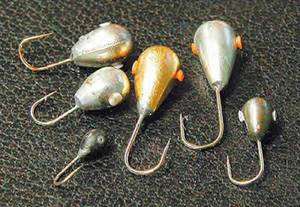
You need to look for universal baits during the experiment, which often show themselves to be catchy. For fishing with bloodworms, color is not so important. It is better to have products in a set of at least three colors - light (silver or gold), medium (copper, dark yellow, red) and dark (black, dirty gray). Thus, for a complete, universal arsenal, the kit should contain the following types of bait, several pieces of different weights and colors.
Ball
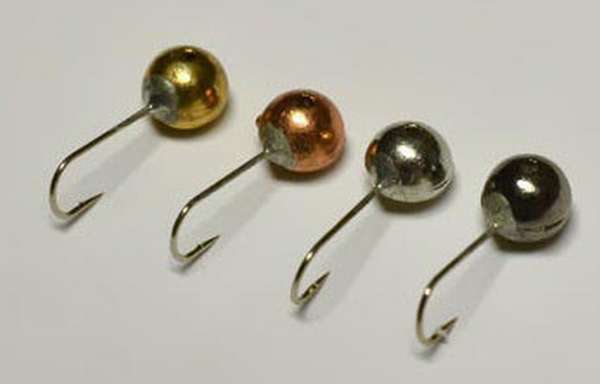
Classic catchy jigs for roach. Also known as pellet. The smallest ones, weighing up to 0.1 grams, can be used on additional leashes. When fishing at night, light-accumulating baits with a phosphorus spot sometimes work well.
Ovsinka
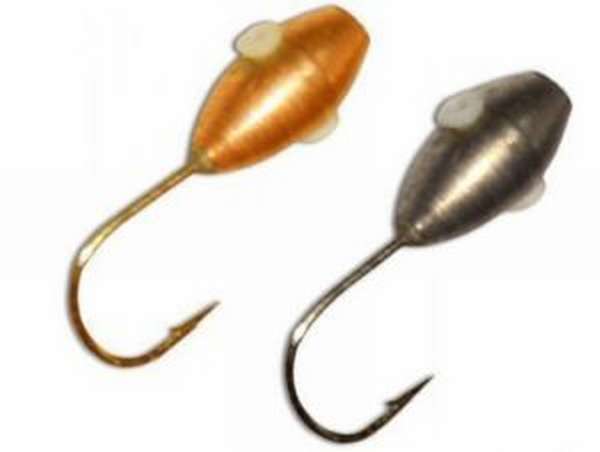
These products resemble the shape of a grain. Due to the thicker (heavier) upper part they have a peculiar play. When released, they seem to turn over and peck downwards with this heavy upper half.
Uralka

Similar to the previous bait with a heavy “nodding” upper part, with a similar, but more amplitude game. Very often, winter fishing for roach with such a jig is carried out in a no-attachment version.
Tablet
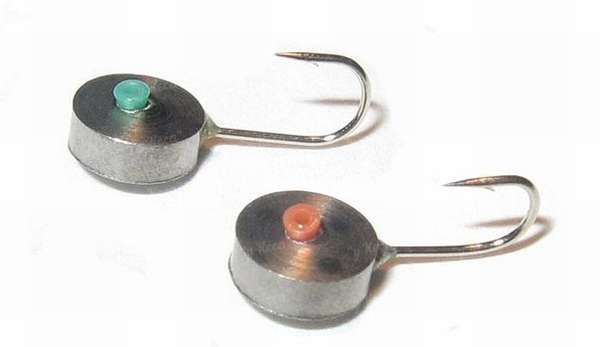
Another bait of the old, classic design. It works well when standing fishing from the bottom at great depths, as it is heavy and flat and lies firmly on the bottom. But it can also be useful when fishing for a game in which it will make gliding oscillations in different directions.
Crystallic
Has a hexagon shape. Features: the glimmer of the edges in the depths of the water.
droplet
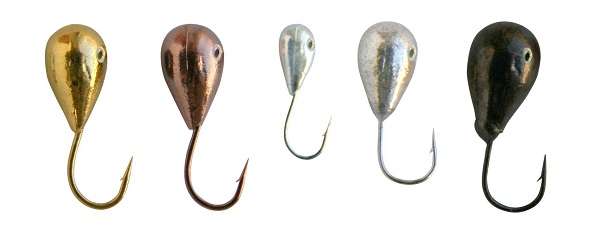
A common form of jig for roach in winter, it has a lot of options and colors
These are not all types. The variety of such baits is great. And only the fisherman’s personal experience and specific fishing conditions will tell you exactly what to use on each fishing trip.
DIY reelless jig
To make a catchable roach reel with your own hands, use the soldering method.
Algorithm for creating a bait:
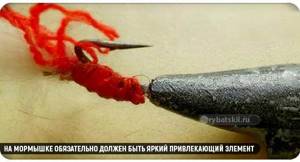
- Melt small pieces of lead, following safety rules.
- After cooling, form a ball, you can use a different shape.
- Cover the workpiece with a thin metal plate and roll it out to a specific length.
- If you need to give a certain shape to the product, then change the angle of inclination when rolling.
- Make a hole in the top of the bait for the hook.
- Add a bright bead, fixing it with glue on the cambric.
Catching sorog in winter with a reelless jig is a promising activity, but it requires knowledge of fishing techniques and the choice of gear. You can catch the coveted trophy both on the first ice and in the dead of winter, the main thing is not to limit the range of baits, and try the game on different horizons.
Varieties
Unwinding nods can be:
- Short or long.
- Hard, soft.
- Straight, bent down (positive bend), backward curved (negative), s-shaped. This factor is chosen by the fisherman out of habit or convenience. Some forms (plastic, lavsan) allow you to change the bend, others (carbon) retain their shape.
- Various manufacturing materials: lavsan, plastic, metal.
A short, hard nod of the reeler will be needed to create a high-frequency game with heavy baits, a long one – for smooth, slow oscillations on bream. However, for high-frequency play with small jigs you need a long guard - and the majority of such jigs are like this. Here begins an endless fermentation among many options. Some nods are conditionally universal - with the proper skill, they can be used to create high- and low-frequency play. Others are specific, tailored for a specific jig, a certain type of game. Experience will tell you which bait to choose for fishing with a reelless bait. To begin with, it is better to use simple universal options - lavsan, swallow wing, clock spring guards. It is impossible to say which nod is better for a reelless bait, apart from the habits of a particular angler, knowledge of the weight of the bait, and the method of play. Article about reelless winter fishing
Taper and test
The nods used in the rewinder are straight and conical. Straight is a strip of material of the same thickness and width throughout its entire length. Conical plates decrease in width towards the end, and double-cone plates also decrease in thickness. This imposes differences on the characteristics. Double-cone nods have a fast action - only the upper third is used when playing. Accordingly, this is the best option for high-frequency, fast gaming.
Straight guards bend evenly under load - this option is more suitable for creating a smooth and slow bream retrieve. A short nod cannot force a heavy reelless reel to play slowly and smoothly. However, these are not all the variables. The rigidity of the nod of the rewinder depends on the length of the plate and the properties of the material of manufacture. Metal has inertia, lavsan is soft, carbon always returns to its starting point. A conical or double-cone nod requires precise adjustment to the weight of the jig, and is ground down manually with sandpaper in each equipment option. Selecting a nod for a rewinder is an age-old question for nozzle-less fishermen. You should focus on personal preferences and the ability to play with a jig. Only with practice will it become clear whether this particular option is suitable for a particular tackle. In this matter, constant experimentation and improvement is important.
Some manufacturers indicate the jig test (weight of the jig) for which it is intended. For a beginner, such store-bought solutions eliminate some of the issues. However, it often becomes clear over time that this option is not suitable for other tasks (a different game, greater depth). You have to buy a new one and look for other solutions. Experienced mothless workers often make mothless guards for themselves on their own.
Operating principle, resonance phenomenon
It is difficult to create a monotonous high-frequency game with a short nod; this requires a fairly well-trained hand in such wiring. With a fishing rod it is necessary to create vibrations of the same small amplitude at the required speed without failures. It is easier to do this with a long guard, since due to vibration, the large amplitude of vibration of the fishing rod (which is easier for a person simply anatomically) is converted into a small one, and the frequency remains the same. However, for this, the long blank must be correct, have certain rigidity indicators, and correspond to the weight of the reelless machine. Therefore, the long version is often used for baitless baits - it is easier for them to create a high-frequency game without failures. At the same time, the arc for cutting increases, accordingly, it needs to be done more sharply, sweepingly than with a short guard (in order to have time to pick up the slack).
Due to this phenomenon, craftsmen create forms that have a vibration frequency of the tip several times greater than the movements of the fishing rod that produce them. During one swing of the whip, the working part of such a guard produces several oscillations of equal amplitude (not to be confused with manifestations of inertia). This phenomenon is called resonance. To obtain a resonant nod, weights are hung on it in various places. Such weights are called resonators. These can be lead weights, beads, wire rings placed on a form. Getting the resonance right will take time and experimentation. The resonators are shifted or changed in weight until the guard produces the desired frequency an order of magnitude higher than that of the whip when oscillating.
Types of nozzles
The most common classification is based on the weight of the ice fishing reel. Jigs are conventionally divided:
- Heavy, used when fishing in deep waters or fast-flowing rivers. Thanks to its heavy weight, the bait quickly reaches the bottom.
- Medium, they are small in size and weight, therefore they are considered universal products that are widely used when catching large and small underwater inhabitants.
- Lightweights are the smallest baits that are ideal for fishing in shallow areas of reservoirs with little current.
On store shelves you can increasingly see new products from various manufacturers. Along with the emergence of new models, the technique of making jigs is being improved.
Increasingly, in the production of bait, modern materials are used that can increase the weight of the bait without “inflating” the size. These include tungsten baits.
Advantages of a rewinder
Reelless fishing is very different from fishing using natural bait or bait. In the first case, the jig seduces the fish due to its game, appearance, vibrations and other factors affecting the senses of representatives of the ichthyofauna. In the second, the main task of the bait is to deliver the bait to the fishing point. The game itself and appearance are of secondary importance.
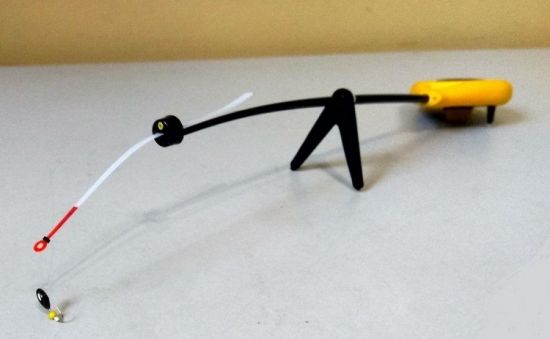
A classic equipped reelless fishing rod that is suitable for any beginner
The main advantages that a reelless reel provides to anglers are:
- efficiency throughout the winter;
- a huge variety of jigs and options for their equipment;
- the ability to use various fishing techniques;
- works on all bodies of water;
- allows you to target large fish;
- relative cheapness of gear (many elements can be easily made independently).
One of the disadvantages is the difficulty of fishing. The fisherman must have a good grasp of fishing techniques, imagine the behavior of the jig in the water, adapt to the mood of the predator, and be able to use different techniques for animating the bait.
Winter jigs
Such baits have an unusual shape, bright color and small dimensions (so as not to scare away the prey). Both attachment and nozzle models are used. To increase catchability, the design of the latter involves the presence of multi-colored beads, pieces of foam rubber or plastic. Of the 10 nominees reviewed by the Vyborexperta.Ru team, 4 best winter jigs were selected based on the greatest attractiveness for passive fish.
Ladoga
The model with a diameter of 0.4 cm is particularly popular and in demand among fishermen, since the shape of the ball is suitable for all types of reservoirs. It will help you catch both shallow ponds and fairly deep holes in winter fish stopover areas.
The heavy weight of the tungsten jig will make it easy to hold it in fast river currents. The red color with the addition of a light bead promotes effective mothless hunting. If desired, you can use bloodworms. Ladoga is suitable for catching perch, crucian carp, carp, pike perch and other peaceful and predatory animals.
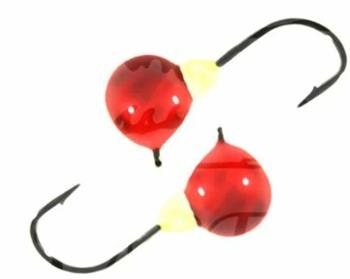
Advantages:
- Excellent balancing;
- High-quality assembly;
- Affordable price;
- Suitable for micro jig fishing;
- Can be used in winter and summer.
Flaws:
- Not detected.
Due to its optimal size and shape, Ladoga is an ideal option for improving the skills of beginners.
Double witch
The unusual design of the bait contributes to high efficiency in catching predatory and peaceful fish of medium and large sizes. The body of the jig is equipped with a wire frame with 3 loops, which securely fixes 2 hooks.
To ensure unique play on leashes, the hooks are not soldered in, but flutter freely in the water. An additional provocative element for future mining here are beads of various shapes in bright colors.
The double witch is at its best at the beginning and end of winter. It is not advisable to use it in the middle of this season, since aggressive play scares away sleepy fish.
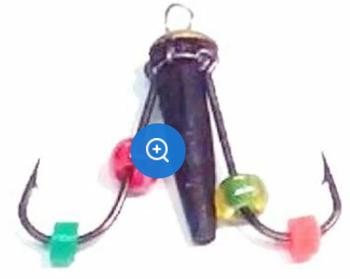
Advantages:
- Perfectly imitates a beetle;
- High quality;
- Sharp hook;
- Low price;
- Suitable for working in currents.
Flaws:
- Not suitable for catching small fish.
It is not recommended to use bait in reservoirs with small fish, as its large size will scare the living creatures.
Ant
...I was looking for cheap options for fishing gear for winter fishing. The ant showed excellent playing and diving qualities. The bait is highly catchable not only in winter, but also in spring, autumn and summer...
Expert opinion
Visually, one of the best jigs for winter is very similar to a real ant, which is an excellent treat for peaceful and predatory fish. The most effective bait of this type is on the first ice. Their combination with spinners or hooks is possible.
The ant is distinguished by high quality workmanship. Carefully machined edges of the hole eliminate the possibility of damage to the fishing line. Thanks to their increased diameter, it is possible to install a piece of thin cambric. This allows you to use fishing lines with the lowest density without losing strength at the knot.
Advantages:
- Suitable for bloodworm attachment;
- Flow stability;
- Low cost;
- Optimal ratio of diameter and weight (2.5 cm:0.34 g);
- A tempting reflection of the surface when hit by light.
Flaws:
- Lack of choice of colors.
Wolfram
The product from the Stolbik series is made of high-quality tungsten with a protective paint coating. This contributes to the high resistance of the structure to mechanical and corrosive effects.
The striking green color will be clearly visible from a great distance. A bright brass cube on the hook is an excellent addition for provoking predatory fish, which is especially important in conditions of low activity. A tungsten jig is suitable for fishing for brush, crucian carp, roach, soruce, as well as rudd, white bream, perch and bream.
Wolfram shows good catchability both in depth and in shallow water, even with low amplitude and frequency of nod oscillations. A sharpened single hook made in Japan and Norway significantly increases the chances of successful hooking.
Advantages:
- Reliable fastening of the hook to the body of the tackle;
- Durability;
- Optimal ratio of weight (0.8 g) and diameter (2.5 cm);
- Inexpensive;
- No special game rules are required for correct wiring.
Flaws:
- Not detected.
You can increase your fish catch by using an additional leash with a hook.
Behavior of perch on the first ice
An exact imitation of an insect is the definition of a reelless jig. Its color, shape and size fully correspond to the insect. To revive it, there is a special movement technique that is supplied to the jig through wiring. All the fisherman needs to do is present it correctly. Features of jigs:
- Almost all insect prototypes are vertical.
- Each jig is equipped with a hook. Given the position of the body, it is slightly forward.
- Models with a distant hook location need camouflage. Their design features allow you to hide the hook in various ways. Because of this, the jigs look elongated.
When you put a nozzle on a jig, it should look like a bug in appearance and move in the water just like an insect.
In some reservoirs, immediately after the first ice forms, the perch bites perfectly, but in others, not so much. In some places, the striped fish stabilizes in the bite a week or two after the formation of ice. The bite may be uniform throughout the day, but more often the activity of the predator in each specific body of water falls and increases according to a schedule unique to that place.
The tendency is to search and fish from the coastal strip. The fry has not yet rolled down to the depths on the first ice. The food supply is located near the shore, in the thickets or in close proximity to them. Perch will also be circling here. Even large perch during this period can be found not in holes, but in relatively shallow water not far from the shore. On small rivers - anywhere, since there are any places - not far from the shore and thickets.
Reelless fishing uses thin and neat fishing rods, monofilament no more than 0.14 mm. In the rig, a single system is formed, consisting of a jig and a fishing line thickness matched to its weight and a nod adjusted for elasticity. The fishing rod itself is a lightweight sports class or homemade one. Options for nodule-free equipment are also possible, when the bite and play of the jig is felt in the hand.
Jig rating
Before compiling the rating, a large number of customer reviews were analyzed, based on which we selected 20 popular jigs. Consultations with sellers and fishermen helped determine the advantages and disadvantages of each model.
When creating the TOP, the following characteristics were taken into account:
- Type – attachment, nozzle or universal;
- Season – winter, summer or universal;
- Shape and material;
- Weight, size and color;
- Availability of protective coating;
- The number of hooks, their hookiness, sharpness and length;
- Game stability;
- Fastening the fishing line - through a hole or eyelet;
- Variety of colors;
- Stability in strong currents;
- Reliability of the design.
The selection also took into account the degree of depth, buoyancy, additional equipment, ease of use, price-quality ratio. The result of the analysis of the characteristics of each nominee, their comparison and testing was the inclusion of 7 winners in the TOP.
Well, now about the most important thing - about reelless jigs
Their peculiarity is that they are always suspended at an angle of more than 90 degrees, unlike “pellets” and other ordinary jigs that hang strictly horizontally. This gives them the opportunity to play with the weakest and most insignificant movements.
No-attachment jigs can be divided into the following subtypes: baits, where the hook is rigidly attached, and jigs with a suspension, where the hooks are located either on top or on the sides of the bait. The first include the most popular jigs, including the well-known “goats” with double soldered hooks. These jigs have proven themselves to be a stable and active bite. For catching low-active fish in the so-called “dead winter”, jigs with a suspended hook are better suited, which also includes the well-known “devils”, which also have an upper hook (read more about fishing with a “devil” from ice here). But “goats” work much faster precisely due to the fact that the hooks are double and fixed motionless, which allows you to remove fish faster
And this is important when you need to keep a hasty school of fish at the hole
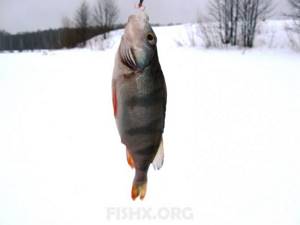
Another feature of no-attachment jigs is their ability to perform additional types of play and create a sound background. These baits have various baits in the form of beads, cambrics, hairs, feathers, and chains. Therefore, outwardly, the jig has a very attractive and mysterious appearance for fish. In addition, beads, hanging hooks, and chains actively move, creating sounds that attract curious fish.
Technique of playing with no attachment
In reservoirs that are not too pressed, perch confidently takes the first ice with a reelless bait. The point of tactics for active fish is to find working points and choose the right reelless reel with a certain playing technique. But even on the first ice, the striped robber does not always readily respond to bait. Sometimes the perch needs to be tortured by picking up jigs, combinations and provocations, running between the holes.
Techniques for working with gear and equipment for devils, bulldozers, pizdriki - in the relevant articles at the links. Here we will dwell in more detail on the technique of catching perch on the first ice with a regular reelless jig - a small light jig with an artificial decoration on a hook on a light fishing rod in a nod or nodless version.
As already mentioned, after a couple of retrieves with wide strokes to attract perch from afar, we begin the usual basic perch retrieve. These are dotted rises with micropauses of a certain frequency, amplitude and height. There are many ways to play - both for certain jigs and in the hands of different anglers.
- The general rule is uniform play, without glitches or parasitic movements. There is no need to strive to make the frequency as high as possible at the beginning - the mythical 300 vibrations per minute. Better slower - but without crashes.
- The mothless game consists of cycles, and each cycle consists of combinations. There is no need to change the combination within each cycle. This is the point - to make several identical combinations, to irritate the fish with monotonous movements - this will be a cycle. We do a change of wiring, provocation, additional animation not at the end of the combination, but after a cycle of identical repetitions.
- The animations themselves - twitching, tapping on the bottom, rising and falling - are known, we will not repeat them in vain. All this is copied on every fishing site. The essence of these movements for the rewinder is not mindless repetition and study of all the described methods. It won't work that way. It's better to focus on one basic animation and get better at understanding how it works, coupled with a properly set up fishing rod.
There is no need to specify a specific vibration frequency. Simply because it is difficult to count, and besides, each person will have completely different motor skills in all his movements. And we should not forget about the monotony of movements. As a result, there is no point in twitching the bait very often if the monotony is lost. It’s better to be sluggish, but monotonous.
Find the “golden mean”. Play as often as you can without any crashes. As a rule, the result will be different for everyone.
The “classic” of the genre is the start of oscillations at the bottom, for a period of 2-3 seconds, and then smoothly raise it to 30 cm. Often a bite comes during the descent, so do not stop playing, lowering the jig to the bottom. Within an hour or two you will figure out how the fish behaves and which technique will be the most successful.
Make grooves from time to time - they are useful in their own way. If the first cycle does not give a bite, pause on the next one. For example, leave for 6-8 seconds and stop for a few seconds. From time to time this pause can provoke a bite.
Sometimes, if monotonous activity is not bearing fruit, try changing the pace.
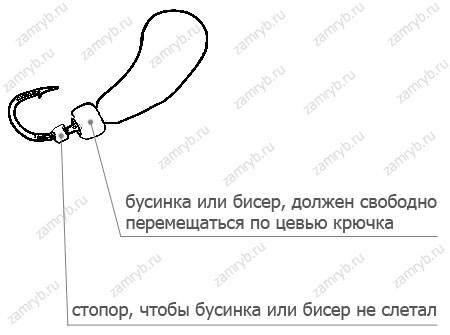
At the slightest suspicion of a bite, resolutely hook. As soon as the fish “tastes” it, it will immediately understand that it is inedible, and will not be suitable a second time. The disappearance of a fish may not only mean its “departure”, but will also alert others. Moreover, no one will swallow a naked jig completely, like a bloodworm. Accordingly, the hook will not be deep, and if you pull it with all your might, you can simply rip it out.
To summarize, we can say that fishing should be harmonious, soft, but decisive.
Dear friends, we wish you pleasant impressions and quality catches in the field of reelless fishing!
Reelless fishing gear
Catching fish can be done not only from ice; fishing in open water with properly assembled gear is no less effective .
Fishing rods for winter fishing
For fishing with a reelless bait, all winter fishing rods that are used for fishing with a regular jig are suitable. It is better to give preference to medium-sized options; however, they should not be very light, but there is no need for excessive heaviness in the hand.
It is necessary to regulate the game with a nod, so when choosing it for winter fishing you should pay special attention. It is best to use lavsan, and select it for a specific jig. The length must be at least 8 cm, and the nod itself must be ground into a cone.
Choosing a fishing rod for reelless fishing in summer
It is best to fish with this bait in open water from a boat. To do this, use rods 3-4 meters long with equipment for a side nod. When catching from the shore, you will need a longer rod; it is best to use a 6-meter stick.
What are the features of fishing in winter with a reelless bait and its basic principles?
Experienced fishermen, who have eaten a ton of salt fishing with reelless fishing, note the fact that this method of fishing always provides the angler with a catch throughout the winter, despite some opinions that it is better to fish with a reelless only on first ice. Of course, the fisherman should know the peculiarities of such fishing, the behavior of the fish caught in winter, the specific conditions of the fishing reservoir and many other circumstances.
It happens that beginners just can’t catch anything in the winter with a reelless bait, despite all their efforts, well, the fish don’t come and that’s it. The mistake of beginners when fishing with reelless baits is to look for some super-wonderful way of playing, but this is a fundamentally wrong approach. The two most important rules of ice fishing with reelless baits are:
- fishing with a reelless bait means a monotonous type of game, sometimes it is much better to play slowly and sluggishly, but at the same time monotonously, and it is important not to stray from the adjusted rhythm of monotony, so as not to scare away the fish that has approached and is ready to bite, the fisherman gains experience in such a game with experience, the more often you fish with reelless reels, the more experience you have; - but in order to achieve the correct game when fishing with reelless fish in winter, you should assemble the equipment in the correct way, the options for fishing with reelless reels are the same, regardless of the type and type of jig used, either the bait is a fishing line-nod-hand of the fisherman, or a bait-line, a whip, the fisherman’s hand in the case of fishing with a nodless reel. In this case, the equipment is selected based on the weight parameters of the bait itself; among other things, the equipment should be light and sensitive to bites.
At the same time, fishing with reelless fishing means fishing with bare hands in the cold, so the angler must be prepared for this; some anglers use fingerless gloves. Fishing with reelless baits is done with the fingers, and playing is done with the hand.
Fishing with Mormyshka from Ice: Features
Fishing with Mormyshka from Ice has its own characteristics. There is nothing complicated here, and no supernatural knowledge or skills are needed. But there are still some little tricks and subtleties.
One of the most important requirements in jig fishing is its action. Everything will depend on how you play with the jig, that is, with the tip of the rod. But it also happens that the fish does not respond to the game, but is best taken in a standing position, with the addition of bloodworms. Therefore, be sure to try all fishing methods to determine which is more successful.
Table of contents
— Features of Fishing with a Jig ↓ — Fishing with a Jig with Alexey Pugach (Video) ↓ — How to Fish with a Jig. Fishing Techniques and Tactics ↓ — How to Catch the Devil. One of the Most Catchable Jigs (Video) ↓ — What types of jigs are there? ↓ — In winter to Bezmotylka. Tackle, Technique and Tactics of Fishing (Educational film) ↓
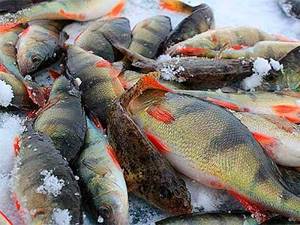
237 kilograms of fish from one hole!
The detained fishermen told the secret of a good bite. The fishery inspectors were surprised by the lack of prohibited equipment...
Read more
Winter Fishing with Mormyshka consists of:
— rod with a whip; — Fishing lines ; - Nod ; - Jigs .
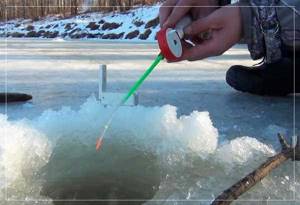
To see a bite, all your attention needs to be focused on the nod (rod tip), since this equipment does not have a float and a sinker. As for jigs, their variety is simply off the charts. Moreover, they differ from each other not only in the material from which they are made, but also in: weight, size, shape and color.
Now you can buy any jig you want in the store. It is also not difficult to make a jig yourself, which is what many fishermen do. It is simply impossible to say in advance which jig will be the most catchy. When going fishing, it is advisable to have 10-15 jigs in your arsenal, varying in weight, material, color and shape.
Fishing with Mormyshka with Alexey Pugach (Video)
Fishing technique and tactics
In terms of technique and tactics, fishing with a mothless fish differs significantly from fishing using bloodworms or other bait. It involves active movement around the water area, continuous search for fish, selection of the optimal jig and retrieve.
Depending on who is being fished, it is necessary to change search tactics, jigs and their animation. In addition, the choice of technique and tactics is influenced by the weather and fishing time. For example, fishing on the first ice is very different from reeling in February.
Perch fishing
Fishing for perch with a reelless reel in winter has many fans. In terms of effectiveness, this direction competes with vertical spinners and balancers, and allows you to successfully hunt for the striped robber all winter on any bodies of water (from the endless expanses of reservoirs to small toad grasses and ponds).
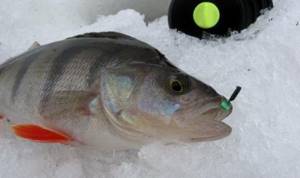
Perch is the main object of fishing for any fishermen
The best jigs for perch are:
- Uralka,
- pellet,
- ant,
- a drop.
These lures love high-frequency action called "dribbling" or "shaking"
Available underwater footage, which is easy to find on the Internet, shows that active and noisy fuss attracts the attention of the striped robber, can attract passive fish, and can gather a large number of predators at the hole
A reelless reel for perch is a formidable weapon in the hands of a seasoned “penguin”. By using large jigs, you can effectively catch a heavy predator. Often trophy specimens fly in, which are not always ready to attack the spoon, preferring smaller, but no less appetizing baitless ones.
On the first ice
The beginning of winter is the most favorable time for hunting the striped robber with a rewinder. At this time, the predator behaves actively, quickly attacks the offered bait, and is not capricious. It is on the first ice that it is recommended to start mastering fishing with a baitless jig, since not catching a fish during this period is more difficult than getting it to sit on the hook.
The best jigs for first ice are Uralka, Ant, and pellet. They respond to fast play, collect fish well to the hole, and seduce perch of various sizes. For targeted fishing of a heavy predator, it is recommended to use a banana or a goat.
On first ice, you can’t stay too long on one hole. You have to constantly move around the water area, drill into the ice and look for perch. As a rule, it is enough to make a few lifts of the jig to determine the presence of fish and its mood. If there are no bites or a small perch takes it, then you need to change the point and continue the search.
Bream fishing
Bream is a difficult fish to fish for, since it inhabits mainly deep areas of water bodies and loves currents. It is not easy to use a jig in such conditions, but this fact does not stop experienced fishermen who know how to find an approach in the current situation.
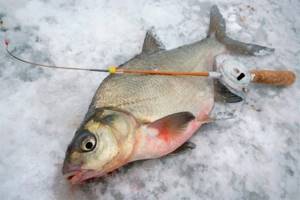
Bream requires large, heavy jigs
Catching bream involves using heavy jigs. As a rule, uralks and large pellets made of tungsten, less often lead, are used. A separate category is devils. They can be used individually or several at a time. This direction of winter fishing is called “garland” and allows you to quickly fish all horizons in deep areas of reservoirs.
Advice! It will be difficult for a beginner to master catching bream on his own using a reelless reel. It's better to take lessons from professionals.
Bream loves a calm, smooth game. Sometimes it is enough just to slowly raise or lower the jig so that the fish reacts to it. It is advisable to take pauses, the duration of which can range from a second to ten.
Roach fishing
The roach responds very well to the rewinder. This is confirmed by the large number of fans of its fishing without bait and impressive results, especially when purposefully hunting for medium and large specimens.
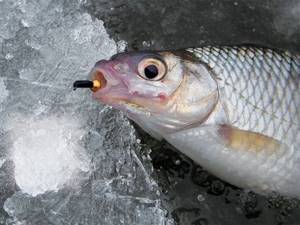
Roach can be caught well with a “naked” jig
Reelless fishing works well on the first and last ice. The best jigs for fishing for roach are:
- nymph;
- oatmeal;
- banana;
- pellet.
Roaches love black and brightly colored baits. Responds to different games. Active fish greedily attack fast, noisy objects. Passive individuals are wary of “buzzing” jigs, but they are not averse to catching prey making smooth, unhurried movements.
Roach, like no one else, loves the various additional elements that are equipped with nozzle jigs. These can be banal beads and cambrics, as well as chains, discs, wings, threads, lurex, etc. Anglers need to constantly experiment, choosing the optimal combination.
What gear is used for catching perch?
When planning to go fishing with a reelless reel, many fishermen do not know what gear to use. Either use jigs, or pay attention to small spoons or baitless baits.
Each angler should choose what he likes best.
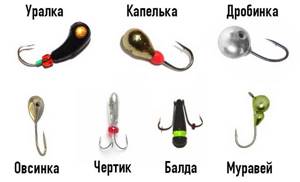
Today, such a reelless reel for perch is in demand:
- "Uralka". This type of jig is considered universal. It has a red, orange, yellow or white bead hanging on a hook. In order for fishing to bring not only pleasure, but also benefit, you should purchase a fishing line whose diameter does not exceed 0.12 mm. Ideally – 0.06-0.08 mm. In addition, we must not forget about the nod and fishing rod.
- "Pellet". A tungsten element with a black or white bead can be used not only when the first ice appeared, but also at other times. Sometimes fishermen use a "shot" made of lead with a brown or black bead on the line and a small piece of sponge at the end. In a word, you need to pay special attention to the color of the beads, because one shade can attract one flock, and another - a completely different one.
- "Ant". When fishing with this element, special attention is paid to the bright and colored “eyes” located on the sides. As for size, small “ants” are often used. Some fishermen do not understand why the size of the product does not change at different depths. The reason is that the average size can scare the perch. It is allowed to use large ants at depths of over 4 meters and in currents.
- "Oatmeal." These jigs come in different sizes, diameters and weights. Thanks to the product, it is possible to catch both small perch and impressive-sized fish.
- "Droplet." The choice of jigs of this type is due to the inclined suspension. Such a product, swaying, can attract fish even at the bottom. If we talk about color, most fishermen prefer green, purple, brown, red, and black baits. At the same time, grains made of rubber in black, red, yellow or white shades are planted on the shank of the hook.
Important! If the water is very cloudy, then rubber will not work. In this case, it is best to use yellow beads or durable white foam rubber.
If we talk about tungsten jigs, they have their advantages, which include significant weight. Thanks to this, it will be much easier to lower them to the bottom of the reservoir. In addition, with the help of such a jig you can play better with a nod. For the last ice, a red or black drop, the diameter of which is about 2.5 - 3.5 mm, works well. As practice shows, perch bites well on jigs that look like fish eyes.
It is not uncommon for fishermen to use a baitless “devil”. True, in order to improve your chances and catch as many fish as possible, you should string another fly or small jig onto the fishing line, placing it slightly higher than the main bait.
It is worth noting that when choosing a jig, you need to pay attention to the diameter, weight, and hook. As for the latter, it plays a big role, since if you choose a low-quality element, you can sit on the river for a long time to no avail.
The problem with hooks is that they are either small or blunt. Of course, this is much easier with modern models. As for old-generation lead elements, this happens all the time.




